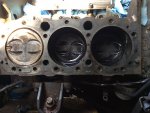Hello All,
I apologize in advance but would rather ask questions now then start a how to replace parts posting in a few months.
I have a 99 4.3L Carb Gen+ (0L323711). I also have a heated shop I can work in but not keep the boat in all winter. My overall plan is to store the boat with the drive off, spread the drive off maintenance over winter and keep the drive in the heated shop. So please confirm my ideas/thoughts. Also since I have been working on the boat all summer it has only been used about a hour.:facepalm: That also means that the fuel in the tank is left over from last Sept. I assume I need to get that drained. But since it already has stabalizers in it can it be used for the running portions of winterizing. Also boat is only used in fresh water. Does step 7 in the manual, the step referring to a fuel shut off valve only apply to the EFI engine. Not sure why I need to stop fuel in a carb engine.
So here is my plan, following Don's sticky and the Merc Manual.
1. Run Boat and do oil/filter change.
2. Start motor and idle around 1500rpm, squirt fog oil in until lots of smoke start is coming out exhaust, return to idle and shutdown. (is there a chance of water ingestion in this step)
3. Drain all 4 plugs, 2 on block and 1 on each manifold, then pull recirculating house from water pump and drain it.
3. I assume I have a 140 thermostat since engine never got above 150, so I will be replacing with a 160 per Merc manual. Pull housing and replace thermostat. Since I got it open I will fill block with Anti-freeze.
4. Fill Manifolds with anti-freeze.
5. Drain the drive
6. Remove Drive and refill drive with oil. I do have the lube monitor so is there a catch with leaving drive filled but not on the boat.
7. Drain gas tank, change filter (what is a good way to drain a tank under the floor)
8. Over the winter months as I get time, inspect/replace bellows, bearing, alignment, etc.
Thanks again for everyone's input.
I apologize in advance but would rather ask questions now then start a how to replace parts posting in a few months.
I have a 99 4.3L Carb Gen+ (0L323711). I also have a heated shop I can work in but not keep the boat in all winter. My overall plan is to store the boat with the drive off, spread the drive off maintenance over winter and keep the drive in the heated shop. So please confirm my ideas/thoughts. Also since I have been working on the boat all summer it has only been used about a hour.:facepalm: That also means that the fuel in the tank is left over from last Sept. I assume I need to get that drained. But since it already has stabalizers in it can it be used for the running portions of winterizing. Also boat is only used in fresh water. Does step 7 in the manual, the step referring to a fuel shut off valve only apply to the EFI engine. Not sure why I need to stop fuel in a carb engine.
So here is my plan, following Don's sticky and the Merc Manual.
1. Run Boat and do oil/filter change.
2. Start motor and idle around 1500rpm, squirt fog oil in until lots of smoke start is coming out exhaust, return to idle and shutdown. (is there a chance of water ingestion in this step)
3. Drain all 4 plugs, 2 on block and 1 on each manifold, then pull recirculating house from water pump and drain it.
3. I assume I have a 140 thermostat since engine never got above 150, so I will be replacing with a 160 per Merc manual. Pull housing and replace thermostat. Since I got it open I will fill block with Anti-freeze.
4. Fill Manifolds with anti-freeze.
5. Drain the drive
6. Remove Drive and refill drive with oil. I do have the lube monitor so is there a catch with leaving drive filled but not on the boat.
7. Drain gas tank, change filter (what is a good way to drain a tank under the floor)
8. Over the winter months as I get time, inspect/replace bellows, bearing, alignment, etc.
Thanks again for everyone's input.





















